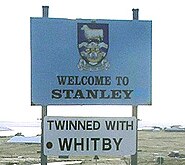Stanley, Falkland Islands
- "Port Stanley" redirects here. For the town in Canada, see Port Stanley, Ontario.
Stanley, Falkland Islands | |
|---|---|
| Map of the Falkland Islands showing position of Stanley. Map of the Falkland Islands showing position of Stanley. | |
| Country | United Kingdom |
| British Overseas Territory | Falkland Islands |
| Population (2001)[1] | |
| • Total | 1,989 |
| Time zone | UTC-4 (FKT) |
| • Summer (DST) | UTC-3 (FKST) |
| Website | http://www.falklandislands.com/ |

Stanley (formerly known as "Port Stanley") is the capital and only town in the Falkland Islands. It is located on the isle of East Falkland, on a north-facing slope, south of Stanley Harbour, in one of the wettest parts of the islands. Its population is around 2,000 people. It is the world's southernmost administrative centre; however, as the Falklands are not a sovereign state, it is not usually categorised as the world's southernmost capital city— that status is generally given to Wellington, New Zealand.
History
Work on the settlement began in 1843, with it becoming the capital in July 1845. It was named for Lord Stanley, Secretary of State for War and the Colonies at the time.
The settlement soon grew as a deep water port, specialising at first in ship repairs, indeed, prior to the construction of the Panama Canal, Port Stanley was a major repair stop for boats travelling through the Straits of Magellan. The rough waters and intense storms found at the tip of the continent forced many ships to Stanley Harbour, and the ship repair industry helped to drive the island economy. Later it became a base for whaling and sealing in the South Atlantic and Antarctic.
Later still it was an important coaling station for the Royal Navy. This led to ships based here being involved in the Battle of the Falkland Islands in the First World War, and the Battle of the River Plate in the Second World War.

Landslides (peatslips), caused by excessive peat cutting, destroyed part of the town in 1879 and 1886, the second landslide killing two people.
Stanley Airport is used by internal flights and provides connections to British bases in Antarctica. It was opened in 1979 (previously, internal flights were by seaplane).
Stanley was occupied by Argentine troops for about ten weeks during the Falklands War in 1982 and renamed "Puerto Argentino" (the name gained some support in Spanish-speaking countries, but its acceptance is not unanimous). It suffered some damage, with three civilians killed by British shelling, but after the British secured the high ground around the town the Argentines surrendered with no fighting in the town itself. The land around it was also heavily mined and some areas remain marked minefields.
Miscellaneous

Today, Stanley lies at the centre of East Falkland's road network, and is the main shopping centre on the islands, also possessing the only swimming pool, school, hospital and library. The Falkland Islands Company owns several shops and a hotel in the town. Attractions include the Falkland Islands Museum, Government House, built in 1845 and home to the Governor of the Falkland Islands, a golf course, and Christ Church Cathedral. Christ Church is the southernmost cathedral in the world and is known for its whalebone arch, a totem pole, several war memorials and the shipwrecks in its harbour.
Stanley is also home to the Falkland Islands Broadcasting Station and greenhouses where some of the islands' vegetables are grown. Gypsy Cove, known for its Magellanic penguins, and Cape Pembroke, the easternmost point of the Falklands, lie nearby. Gypsy Cove is four miles from Stanley and can be reached by local bus which runs every hour.
Today, the vast majority of the town's residents are employed by the government, with tourism also being a major source of employment; on days when two or more large cruise ships dock in the town tourists may outnumber the local residents.
External links
References
- Falkland Islands: The Bradt Travel Guide, William Wagstaff


